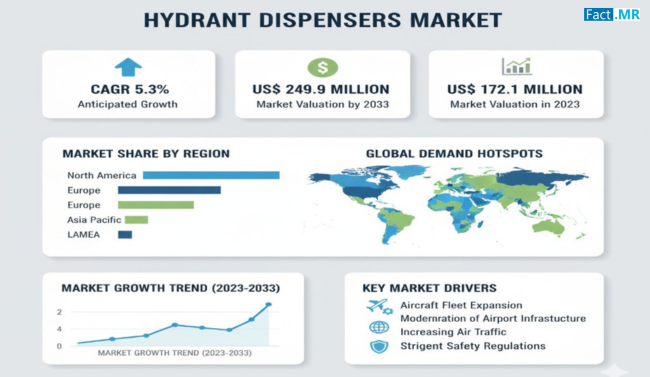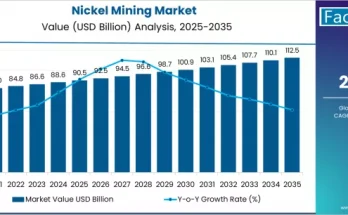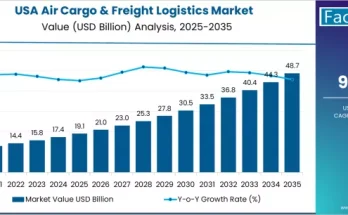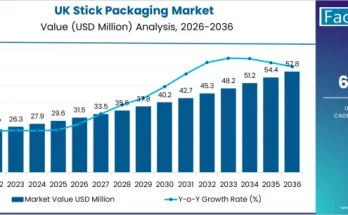Hydrant dispensers are revolutionizing the way airports and military aviation handle aircraft refueling. These specialized systems connect aircraft fuel inlets to underground fuel lines, eliminating the need for traditional fuel trucks to carry large amounts of fuel. By doing so, hydrant dispensers enhance operational safety, reduce turnaround times, and lower overall refueling costs. With the growth of commercial aviation and increasing demand for rapid, reliable fuel supply, hydrant dispensers are becoming indispensable infrastructure in modern airports.
Market Overview:
The hydrant dispensers market comprises specialized vehicles and equipment designed to manage fuel delivery efficiently. The systems vary in design, including towable dispensers and self-propelled dispensers, offering flexibility in operations. Hydrant dispensers provide a modular approach, allowing components to be replaced, upgraded, or exchanged with ease. This adaptability ensures that the system can meet the needs of different airport sizes and aircraft types while maintaining optimal fuel flow and safety standards.
Hydrant dispensers are highly valued in commercial airports, military bases, and large aviation hubs where efficiency, safety, and regulatory compliance are critical. By using these systems, operators reduce the risks associated with fuel handling, minimize labor-intensive tasks, and optimize operational workflow. Furthermore, these systems support the widespread adoption of automation and technology integration in airport refueling processes.
Regional Insights:
North America, led by the United States, is a significant market for hydrant dispensers. The country hosts the largest number of busy airports and military aircraft fleets, driving demand for fast and efficient fueling infrastructure. Investments in airport expansion and modernization, coupled with the need to reduce fuel handling risks, are boosting the adoption of hydrant dispenser systems.
In Asia-Pacific, countries like China are witnessing increasing demand due to rapid growth in air passenger traffic, rising middle-class income, and expanding airport infrastructure. Military spending and the growth of commercial aviation are further contributing to the region’s adoption of hydrant dispensers. Europe is also experiencing steady growth, driven by modernization projects in major airports and the transition toward environmentally friendly fueling solutions.
Key Trends and Forecast:
Several factors are shaping the hydrant dispensers market:
- Safety and Cost Efficiency:Unlike conventional fuel trucks, hydrant dispensers do not carry fuel, reducing the risk of spillage, accidents, and fuel theft. They also cut logistics and transportation costs by connecting directly to underground fuel systems.
- Adoption of Electric and Hybrid Systems:Electrically powered hydrant dispensers are gaining traction as airports aim to achieve net-zero emissions. These systems, powered by batteries or solar energy, offer cleaner and lower-maintenance alternatives to diesel-powered units.
- Technological Advancements:Modern dispensers incorporate automation, digital monitoring, and mass flow rate optimization, ensuring precise fuel delivery and minimizing operational errors.
- Increased Aviation Activity:Rising passenger numbers and military fleet expansions are directly driving demand for both low-flow and high-flow hydrant dispensers globally.
Applications and End-Use Outlook:
Hydrant dispensers are used primarily in aviation, where safety, speed, and operational efficiency are paramount:
- Commercial Airports:Fast and reliable refueling systems reduce aircraft turnaround times, supporting higher flight frequencies and passenger throughput.
- Military Aviation:Hydrant dispensers ensure safe and efficient refueling of military aircraft, reducing downtime and supporting mission readiness.
- Maintenance and Service Facilities:Airports and maintenance hubs use hydrant dispensers to fuel aircraft during servicing while minimizing environmental and operational risks.
Challenges and Market Restraints:
Despite the advantages, hydrant dispensers face certain challenges. High initial infrastructure costs for installation and maintenance can be a barrier, particularly for smaller airports. Diesel-powered dispensers face increasing regulatory pressure due to emissions, driving the need for cleaner alternatives. Additionally, the complexity of integrating hydrant dispensers with existing airport fuel systems can require specialized expertise and investment in training.
Country-wise Analysis:
In the United States, demand for hydrant dispensers is fueled by the high volume of busy airports and extensive military aviation operations. The country leads in the adoption of these systems, emphasizing safety, operational efficiency, and regulatory compliance. In China, growing passenger traffic and increasing airport infrastructure investments are driving the expansion of hydrant dispenser systems, with both commercial and military sectors contributing to market growth. Europe is also modernizing refueling infrastructure, with airports in Germany, the UK, and France prioritizing automated and environmentally friendly hydrant dispensers.
Conclusion:
The hydrant dispensers market is poised for steady growth, driven by the increasing need for safe, efficient, and environmentally responsible aircraft refueling. By minimizing operational risks, reducing costs, and improving turnaround times, hydrant dispensers are redefining airport fueling practices globally. With technological innovations, the adoption of electric and hybrid systems, and expanding aviation infrastructure, the market is set to play a crucial role in the future of airport operations and military aviation logistics. Companies investing in advanced hydrant dispenser solutions are better equipped to meet the demands of modern aviation while adhering to safety and environmental standards.



